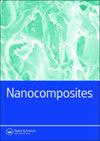Silane compatibilzation to improve the dispersion, thermal and mechancial properties of cellulose nanocrystals in poly (ethylene oxide)
IF 3.7
3区 材料科学
Q2 MATERIALS SCIENCE, COMPOSITES
引用次数: 8
Abstract
Abstract Cellulose nanocrystal (CNC) has potential to be used as a reinforcement in polymeric nanocomposites because of their inherent biodegradability, universal accessibility, and superior mechanical properties. The most crucial challenge faced in the nanocomposite production is dispersing the nanoparticles effectively in the polymer matrix, so that the exceptional mechanical properties of the nanoparticles can be transferred to the macroscale properties to the bulk nanocomposites. In this research, a safe, effective and ecofriendly modification was used to functionalize the surface hydroxyl groups of CNC via silane treatment. These modified CNCs were used as reinforcements to prepare poly (ethylene oxide) (PEO)/CNC nanocomposites. The composites were prepared using solvent casting method. The composite properties were evaluated using Fourier Transform Infrared Spectroscopy (FT-IR), Scanning Electron Microscopy (SEM), Thermo-Gravimetric Analysis (TGA), Differential Scanning Calorimetry (DSC), and Dynamic Mechanical Analysis (DMA). The SEM micrographs demonstrated that the composites incorporated with silane treated CNCs showed improvement in the dispersion behavior of the nanoparticles in the matrix. Oxidative combustion of the composites containing silane treated CNCs promoted char formation and enhanced thermal stability. The composites containing (1:1) silane treated CNCs exhibited the better crystallization ability, highest storage modulus, and lowest tan δ value compared to the other silane treated systems indicating improved dispersion of CNC. The polysiloxane network provided an efficient surface covering of the CNC molecules, imparting reduced polar surface characteristics and enhancing the overall mechanical properties of the composites. Graphical Abstract硅烷增容改善纤维素纳米晶在聚环氧乙烷中的分散性、热性能和力学性能
摘要纤维素纳米晶体(CNC)由于其固有的可生物降解性、普遍可及性和优异的力学性能,有可能被用作高分子纳米复合材料的增强材料。纳米复合材料生产中面临的最关键的挑战是将纳米颗粒有效地分散在聚合物基体中,从而使纳米颗粒的特殊力学性能能够转移到整体纳米复合材料中。本研究采用一种安全、有效、环保的改性方法,通过硅烷处理对CNC表面羟基进行功能化。将改性后的CNC用作增强材料制备聚环氧乙烷/CNC纳米复合材料。采用溶剂铸造法制备了复合材料。利用傅里叶变换红外光谱(FT-IR)、扫描电镜(SEM)、热重分析(TGA)、差示扫描量热法(DSC)和动态力学分析(DMA)对复合材料的性能进行了评价。SEM显微图表明,硅烷处理的cnc复合材料改善了纳米颗粒在基体中的分散行为。含硅烷处理过的cnc复合材料的氧化燃烧促进了炭的形成,提高了热稳定性。与其他硅烷处理体系相比,含有(1:1)硅烷处理的CNC复合材料具有更好的结晶能力、最高的存储模量和最低的tan δ值,表明CNC的分散性得到改善。聚硅氧烷网络为CNC分子提供了有效的表面覆盖,降低了表面极性特征,提高了复合材料的整体机械性能。图形抽象
本文章由计算机程序翻译,如有差异,请以英文原文为准。
求助全文
约1分钟内获得全文
求助全文

 求助内容:
求助内容: 应助结果提醒方式:
应助结果提醒方式:


